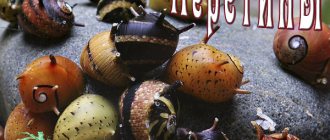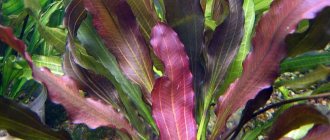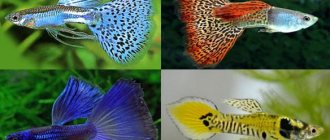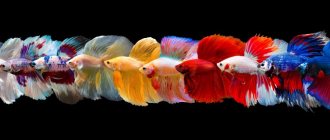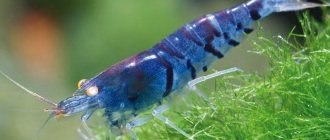In the calm and shallow waters of South America, rich in all kinds of vegetation, red neon is found. This is a very beautiful aquarium fish. Her body is divided horizontally into two parts: the lower one is bright red and the upper one is neon. To provide it with suitable conditions for life in an aquarium, it is necessary to recreate a microclimate in it that is as close as possible to the natural living conditions of the fish.
To breed red neon at home, you need to recreate a microclimate in it that is as close as possible to natural conditions
Habitat in nature
Red neon (lat. Paracheirodon axelrodi) was first described by Schultz in 1956. It is native to South America and lives in slow-moving forest rivers, such as the Rio Negro and Orinoco. It also lives in Venezuela and Brazil.
The tropics that surround these rivers are usually very dense and allow very little sunlight to reach the water. They live in schools, mainly in the middle of the water, and feed on worms and other insects.
Individuals found on sale are already locally bred; small quantities are imported from nature.
Underwater shooting in nature:
Diseases
Neons are generally healthy fish, but some diseases do not escape them. Most often, the owner manages to cure the pets, but prevention is simpler and more reliable. Below is a list of the most common red neon diseases:
In individuals infected with semolina, the entire body is covered with white dots.
- Ichthyophthiriasis or semolina. Along the body of the fish, first white grains similar to semolina appear on the fins.
- A specific disease of this type is plistophorosis or neon disease. It is extremely dangerous and incurable, leading to the death of fish in a short time . Externally it is expressed by discoloration of areas of the body.
- Dermocystidium is a parasitic infection. On the body of fish, a tumor often appears in the eyes, in which a white worm can be seen. Treatment is difficult but possible, although weakened individuals rarely survive.
Description
This is a very small aquarium fish, which reaches a length of about 5 cm and a life expectancy of about 3 years.
A distinctive feature of this fish is a blue stripe in the middle of the body and a bright red one below it. In this case, the red stripe occupies the entire lower part of the body, and not half of it.
It is precisely its large red stripe that distinguishes it from its relative - ordinary neon. He's also bigger physically. When both varieties are kept in an aquarium, the red ones seem to be twice the size of the regular ones.
Notes
This species is extremely popular in the aquarium hobby and is currently grown in large quantities, with breeding forms such as gold/platinum and albino.
Myers and Weitzman (1956) originally intended to describe it as Hyphessobrycon cardinalis, but just before it was to be published, Schultz submitted an alternative description in the Tropical Fish Hobbyist magazine and named the fish after the publication's founder, Dr. Herbert R. Axelrod.
identification:
Red neon (P. axelrodi) can be distinguished from its relatives Neon blue (P. innesi) and Neon green (P. simulans) by differences in color structure.
P. axelrodi differs from P. innesi in that it has much more red pigment on the body, a wider blue lateral stripe, and a less distinct white marking on the anal fin.
It is distinguished from P. simulans by having a bluer (versus greener) lateral stripe that extends only to the adipose fin (versus the base of the caudal fin), more red pigment on the sides, and less blue pigment on the eyes.
Difficulty in content
A complex fish that is more demanding than ordinary neon. The fact is that red is very sensitive to water parameters and its purity, and if it fluctuates, it is prone to illness and death.
It is recommended to be kept by experienced aquarists, since it especially often dies in beginners in a new aquarium.
The fact is that in red neon this stripe goes across the entire lower body, but in ordinary neon it occupies only half of the abdomen, up to the middle. In addition, red neon is much larger.
True, you have to pay for beauty, and red differs from ordinary red because it has higher requirements for living conditions.
It is also small in size and peaceful, and can easily become a victim of other large fish.
When kept in soft and acidic water, its color becomes even brighter.
It also looks advantageous in a heavily overgrown aquarium with dim lighting and dark soil.
If you keep your fish in a stable aquarium with good conditions, it will live long and resist disease well.
But, if the aquarium is unstable, it dies very quickly. In addition, like ordinary neon, red is susceptible to a disease - neon disease. With it, its color sharply turns pale, the fish loses weight and dies. Unfortunately, this disease has no cure.
If you notice that any of your fish are acting strangely, especially if their coloring has faded, pay close attention to them. It’s better to get rid of it right away, because the disease is contagious and there is no cure for it.
In addition, neons are characterized by age-related changes in the spine. In other words, scoliosis. For example, after a few years of life, some of the fish begin to become crooked. According to my observations, this is not contagious and does not affect the quality of life of the fish.
Favorable neighborhood
It is known that this fish prefers a schooling lifestyle. Next to its relatives, red neon looks very impressive and attracts attention. Large schools of these fish look especially beautiful. They are non-aggressive and get along with almost all species. However, they can be swallowed by larger fish, so you should be careful when choosing neighbors for red neon.
It is preferable to choose fish of the same size , or better yet, smaller ones:
- gold, blue and black neons;
- dwarf cichlids;
- Nannostomus;
- labyrinthine;
- small rasboras;
- erythrozonus;
- catfish corridors.
Despite the fact that breeding this type of fish is fraught with some difficulties, it is still very popular among both experienced aquarists and beginners. After all, red neon is very beautiful, unusual and bright - a real decoration for any aquarium.
Feeding
It is quite easy to feed the fish, they are unpretentious and eat all types of food - live, frozen, artificial.
It is important that the food is not large, since they have a rather small mouth. Their favorite foods are bloodworms and tubifex. It is important that feeding be as varied as possible, this is how you will create conditions for health, growth, and bright coloring.
Avoid feeding one food for a long time, especially avoid dry food such as dried gammarus and daphnia.
Red Neon Diet
The anatomical features of red neon confirm the predatory feeding pattern. Their stomach is voluminous, while their intestines are short, being twice the length of the abdominal cavity. Adult red neons do not require much food and can easily endure fairly long hunger strikes.
In an aquarium, red neon consumes any dry commercial mixture. It is advisable to diversify the diet by adding live and frozen food. Preferred are small crustaceans (daphnia, Artemia nauplii) and bloodworms with coretra. It’s not often that the diet can be diversified with crumbs of white bread and semolina scalded with boiling water.
Keeping in an aquarium
Like ordinary neon, red one needs a balanced aquarium with established parameters and soft water.
The ideal pH is below 6 and the hardness is no more than 4 dGH. Keeping the water hard will cause the color to fade and shorten its lifespan.
Water temperature is within 23-27 °C.
The most important thing is that the water parameters are stable, since they do not tolerate surges very well, especially in new aquariums.
The light needs to be dim, but an abundance of plants is desirable. It is best to shade the aquarium with floating plants.
While the red neon needs hiding places, it also needs an open place to swim. A densely overgrown aquarium with a center free of plants will be ideal for keeping.
The volume of such an aquarium can be small; for a flock of 7 pieces, 60-70 liters will be enough.
Reviews
The prevalence of red neons among aquarists is high; everyone notes their brightness and agility. They give the aquarium a feeling of fullness. And coloring attracts attention and allows you to escape from the problems of life, bringing peace. But difficulties arise with adaptation to other fish in the aquarium and with the reproduction of neons.
Compatibility
A peaceful fish that, like other tetras, needs company. It is better to keep a flock of 15 or more, this is how they will look the brightest and feel most comfortable.
Well suited for community aquariums, provided that the water parameters are stable and the neighbors are peaceful. Good neighbors would be black neons, erythrozonus, pristella, and tetra von rio.
Health
The reasons that can affect the health of individuals can be different:
- insufficient oxygen;
- improper feeding (usually overfeeding);
- water temperature (below 15-16 C°);
- water pollution;
- pathogens.
Plistiphorosis
This is the most common disease that kills neon fish. Its second name is “neon disease”. The fungus affects the muscles. The first symptom is a pale color and neon stripe. As the disease progresses, the fish becomes completely discolored and swims on its side or upside down. Then he dies. The disease is contagious, so the sick individual must be quarantined or killed. There is no treatment.
Saprolegniosis
The causative agent is also a fungus. The main causes of infection are poor aquarium hygiene, unbalanced nutrition and overcrowding. You can notice that the fish is sick by a spore-like coating and gluing of the fins.
We invite you to read: What is the character of Asher cats?
The disease received its name due to the common symptoms with plistiphorosis. Only the causative agent is the bacterium Nocardia asteroides. The neon fades, the bright stripe disappears, and a whitish coating appears over the entire surface.
Reproduction
Reproduction of red neon is sometimes difficult even for very experienced breeders. You need a separate aquarium for spawning with stable water parameters: pH 5 - 5.5 and very soft water, 3 dGH or lower.
The aquarium should be well planted with small-leaved plants, such as Java moss, as fish spawn on plants.
The lighting of the spawning tank is minimal; it is better to put floating plants on the surface. Caviar is very photosensitive. Spawning begins late in the evening or even at night.
The female lays several hundred sticky eggs on plants. The parents may eat the eggs, so they need to be removed from the aquarium.
After about 24 hours, the larva will hatch, and after another three days it will swim. From now on, the fry must be fed egg yolk and microworms.
Breeding
Neons have offspring mainly from the beginning of October to April inclusive. There are only two options for obtaining eggs: the paired or school method.
Manufacturers
Red neons become sexually mature at 7-9 months. Fish are placed for spawning at the age of 9-10 months. Young individuals are selected by observing their behavior. By chasing each other, neons show a desire to spawn. One-year-old females and two-year-old males can become breeders. If spawning is paired, then two males are added to one female.
The fish are kept separately for two weeks and fed generously with erythrea. Such nutrition, frequent changes in volume and water temperature of +23 °C stimulate spawning. Neons stop feeding 24 hours before spawning. The spawners are placed in an equipped container (spawning tank) in the afternoon and kept quiet. A few hours before dawn, the female lays 150-400 eggs, and the male carries out fertilization.
To activate spawning, in the morning the temperature is sharply increased to +30 °C and gradually decreased in the evening.
If spawning is delayed, the fish are sent back to the aquarium for 3-5 days. Feeding breeders in a breeding vessel is prohibited.
Spawning tank
For active spawning, take a 30-40 cm glass container. Its volume should be: for pair propagation – 15 liters; for the flock method – 30 l.
The spawning tank is placed on a dark substrate. At the bottom, instead of soil, a separator mesh is spread. Willow root shoots and plants are attached to it, in which the fry will find it convenient to hide. The aquarium is then exposed to the sun for approximately 2 weeks.
The settled liquid is disinfected by exposure to ultraviolet light or ozone and filled to a level of 25-35 cm. Its composition is as follows: hardness up to 2 dGH, alkalinity KH 0, pH 5-6.5. The temperature range for the liquid is narrow: +26…+27 °C.
Fry
The eggs of Red Neons suffer from direct lighting. Therefore, the spawning area is darkened. After spawning, the spawners are returned to the aquarium, which will prevent the parents from eating the eggs.
After 22-30 hours the larvae will hatch. It is imperative to remove the dead eggs. Within 3-4 days, the juveniles lose their yolk sac and begin to swim.
It is typical for the offspring of Red Neon to strive for the source of illumination. They lose orientation in space when there is excess light and cannot feed. For sedentary fry with poor vision, the accumulation of ciliates is vital. They also have phototactic behavior - they move under the influence of light towards its source. Therefore, the container itself is shaded, only the circle into which food suitable for the fry is poured is illuminated. This way the babies will find food: rotifers and tiny ciliates.
After starting feeding, you must do the following:
- start gently blowing liquid into the aquarium;
- increase water hardness;
- introduce a variety of complementary foods into your diet.
For the first two weeks, the Red Neon offspring hides in prepared vegetation. Gradually, a longitudinal stripe appears on the body of the fry, and they take on the shape of an adult fish. Only after the formation of the traditional color can the juveniles be moved into a community aquarium.
Determination of gender
When this aquarium fish reaches 7-9 months, we can say that they are already sexually mature individuals and are completely ready to reproduce. It is not easy to distinguish a female red neon from a male, but thanks to some features this can be done. Unlike the male, the female is larger in size, with a rounded abdomen, and the neon stripe is curved in the middle. The male is slender, bright and nimble, and has a hook protruding from the anal fin.
Preparing the spawning tank
While the female and male are preparing for spawning, it is necessary to prepare a spawning tank for them - a small aquarium or an all-glass container with a volume of 6-10 liters, which is easy to wash and disinfect. It is best to use an elongated aquarium about 40 cm long for this. The prepared container should be disinfected with a weak solution of potassium permanganate, and then rinsed thoroughly with clean water.
The walls of the spawning area should be shaded with old newspapers or thick paper. You can leave the front surface of the vessel open and watch the fish spawn through it.
The light in the spawning tank should be dim and not directed. The top of the vessel should be covered with a glass lid, since during mating the fish are very active and can jump out of the container.
There is no need to pour soil into the spawning tank; it is best to put a piece of Java moss, a nylon mesh, tangled fishing line, a washcloth or willow roots collected in water on the bottom. You can attach several bushes of cryptorina or fern to the bottom.
IMPORTANT: Catfish and snails, which will happily feast on fresh eggs, should not be allowed into the spawning area. In a short time they can clear all the internal surfaces of a reservoir of eggs.
Return to content
